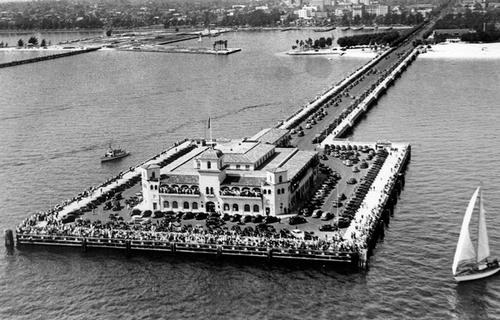Ever wonder about the origin of The Pier in St. Petersburg? Although our area is not steeped in a tremendous amount of history, we do have a fairly long history of “Piers” particularly in St. Petersburg.
Here is a rundown of the earliest pier to the ongoing pier project that will be unveiled in 2020.
St. Petersburg’s Piers Through the Years
THE 1889 RAILROAD PIER
The city’s first pier dates back to 1889, built by railroad entrepreneur Peter Demens. The Orange Belt Railway built the Railroad Pier which extended a half mile into Tampa Bay from the foot of 1st Ave S, the terminus of the railroad. Lined with warehouses and loading docks, the 3,000 ft-long structure soon became popular with anglers and swimmers, prompting the construction of a bathing pavilion and toboggan slide.
THE 1896 BRANTLEY PIER
Constructed by boat builder D.F.S. Brantley, the 1,500 ft Brantley Pier was built to compete with the Railroad Pier, although it never rivaled the railroad pier commercially. A horse-drawn flat car was used to shuttle goods and passengers from water’s edge to and from moored ships at the pier’s head. Its 34-room bathing pavilion proved extremely popular. The Brantley Pier started the tradition of 2nd Ave NE piers. It was replaced in 1906 by the Electric Pier.
1900 FOUNTAIN OF YOUTH PIER
About 1900, Edwin H. Tomlinson built a 2,000 ft pier near the east end of 3rd Ave S along with an artesian well. In 1908 Dr. Jessie F. Conrad was visiting St. Petersburg and happened to sample the well water at Tomlinson’s Pier. He liked it so much that he bought the pier and popularized the well by promoting it as The Fountain of Youth. The pier also came to be known by this name. The water from the fountain, which contained a high concentration of lithium, was eagerly sought by residents and tourists over the years. The pier was torn down in 1927. However, the Fountain of Youth still survives. It is now located at 4th Av and 1st St SE, connected to ordinary tap water.
THE 1906 ELECTRIC PIER
In the years before World War I, the Electric Pier became a major tourist attraction and a symbol of the new St. Petersburg. Known for its hundreds of electric lights and street car line, the Electric Pier extended 3,000 ft into Tampa Bay. Publisher Frank Davis, who also owned the St. Petersburg Electric Light & Power Company and the St. Petersburg & Gulf Electric Railway, developed this pier which became a major tourist attraction. It was demolished in 1914.
THE 1913 MUNICIPAL RECREATION PIER
The first pier to accommodate automobiles, St. Petersburg’s Recreational Pier opened in December 1913. On January 1, 1914, Tony Jannus flew the first flight of the world’s first airline from the Central Yacht Basin by the pier across the Bay to Tampa. Early amenities located along the pier approach included a hangar for the first airline and subsequent aviation use, indoor swimming pool called the Spa, aquarium (which later became the museum of history in 1922), and dance hall and banquet facility. Additional public facilities added through the years included Spa Beach, sandwich shop, tennis courts, the Solarium for nude sunbathing, and a senior citizen’s center. The October 1921 hurricane damaged the wooden pier and it was replaced by the Million Dollar Pier in 1926.
THE 1926 MILLION DOLLAR PIER
Opened in 1926, the Million Dollar Pier and its Casino was a major attraction for the city and a popular gathering space. In addition to Spa Beach, a solarium, and bait houses, the Pier accommodated a two-lane roadway, a streetcar line, an observation deck, and WSUN radio station. Designed in the most popular architectural style in St. Petersburg in the 1920s, the Pier incorporated Spanish, Italian, and Moorish elements, rounding out the City’s Mediterranean Revival style heritage. The Million Dollar Pier was demolished in 1967 due to deterioration.
THE 1973 INVERTED PYRAMID
The Inverted Pyramid, with its radical, forward-thinking structure was built on top of the 1926 pier head. It was designed by noted architect William Harvard, Sr. Completed and opened to the public in 1973, the iconic design continued the tradition of an over-water public gathering place and tourist attraction in downtown St. Petersburg for four decades. Over the years, it housed three restaurants, snack bars, novelty shops, an aquarium and breathtaking views of Tampa Bay. The structure closed in 2013 with demolition beginning mid-2015.
























![Two New [and Very Different] Ideas IN MANHATTAN](https://familybeautiful.com/wp-content/uploads/2016/05/manhattan-100x70.jpg)






